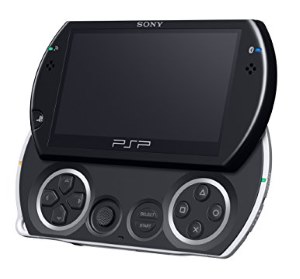Playstation Portable
The Sony PSP is a portable games console produced by Sony between 2004 and 2014. While always designed and marketed as a portable system, later models of the PSP introduced a TV out option which makes them of interest to users of upscalers.
Contents
Models
There were a total of five different hardware revisions. The first revision (PSP-1000) and the last (PSP Street or PSP-E1000) do NOT offer a TV/external display output option. The PSP-2000, PSP-3000 and PSP Go variants DO offer this option however. The PSP Go is particularly attractive to gamers wanting to play on the big screen as it can be paired with a DualShock 3 controller.
When using the PSP with an external display, games are rendered at the 480 × 272 resolution of the PSP screen, rather than the standard 480p (720×480) resolution used for output. This means games are displayed with black letterboxing on the external display. Due to this unusual aspect ratio of 30:17, it cannot be perfectly scaled to modern displays without some amount of letterboxing.
Models tested
Sony PSP Go (with OSSC)
OSSC Specific settings
There are two separate profiles to use with the PSP:
- In the PSP's system menus and other non-game content, the entire 720x480 screen area is used. You therefore want to simply scale the native image.
- In games, the 720x480 screen is letterboxed to produce a 480x272 active region. You therefore want to configure the OSSC to treat portions of the letterbox as offscreen, effectively "zooming" the image.
You can find timing calculations taken from an oscilloscope, and the OSSC settings which result, here.
480p for non-game content
The OSSC's defaults for 480p content are correct.
480p for letterboxed game content
As of OSSC firmware 0.86, de-letterboxing the PSP's image is natively supported. All you need to do is set "480p in sampler" to "PSP 480x272". This outputs an active picture of 480x272 in passthrough mode, and 960x544 in Line2x. Note that Line2x automatically uses a PSP optimized mode when "480p in sampler" is set to "PSP 480x272", so the "Line2x mode" setting is ignored.
If your display has trouble displaying the unusual resolution, you can try cropping the top and bottom pixels, which in Line2x mode produces a perfect qHD (960x540) signal. To do so, use the following advanced settings:
| V. Active | 270 |
| V. Backporch | 135 |
Pairing with external scalers
With the DVDO Edge, Edge Green or iScan Duo
No special settings are required on these scalers to use 480px2 mode, however you can still use the steps/settings below for a more pleasingly scaled image.
With the iScan VP50 Pro (and similar ABT scalers)
To use the OSSC's 480p line double mode in conjunction with the VP50 Pro, first connect your PSP to the OSSC via the component video TV cables and select "Connected Display Settings" on the PSP to switch to TV out mode. You can connect the PSP to the OSSC using AV2 or AV1 with a suitable adapter. Make sure YPbPr mode is selected on whichever input you are using.
Verify that you have a stable image with the basic settings, now follow the steps below to enable compatible 480p line double settings for the VP50 Pro.
1) Navigate to the "Output Opt." menu on the OSSC and enter it. Find "480p/576p proc" and set it to "Line2x". You VP50 Pro will lose picture now, but don't panic.
2) Leave the Output Opt menu and navigate to the "Sampling Opt." menu and enter it. Find "Adv. Timing" for 480p and enter this menu.
3) Enter the following settings:-
- V.Active 360
- H.Active 640
- H.Backporch 95
- V.Backporch 63
After entering those settings, an image should appear on your VP50 Pro
4) Minimise image jitter by adjusting the Sampling Phase under the "Sampling opt." menu. The PSP's pause screen is useful for this, check for jitter around the white text. You may need to re-do this calibration every time you use the PSP with the OSSC.
5) Use the Zoom controls on the VP50 Pro (under Input Asp.Ratio) to zoom and centre the image. The values should be approximately as follows:-
- Zoom->Hor. 1.322x
- Zoom->Ver. 1.322x
- Pan->Hor. 0 or +1
- Pan->Ver. +52
6) Optionally apply post processing to the image. Line doubled 480p produces a very over-sharpened looking image with lots of saw-tooth edges. If you do not like this, there are two things you can do. Firstly, as of firmware 0.78, you can turn on the "Allow Upsample2x" option under the sampling options menu on the OSSC. Turning this on should significantly decrease the jaggedness of the image. If the image is still too over-sharpened for your taste, you can use the VP50's picture controls to soften it further. In the "Picture Control" menu choose "Fine Detail" and reduce this to taste. You can also try reducing the Edge Enhancement setting too. On the OSSC you can turn on scanlines if desired. Although PSP games never had scanlines, their resolution is similar to that of retro consoles and the addition of scanlines may give the image a pleasing retro look and reduce some of the sawtooth edges that 480p line double mode causes.
7) Save the presets/profile settings on both the VP50 and the OSSC so that they do not need to be manually entered next time you play.
Thanks to Nikodem R for these settings. See the Youtube videos below for some footage captured from a iScan VP30 scaler.
XRGB-2 Specific settings
insert data
XRGB-3 Specific settings
insert data
XRGB-Mini Specific settings
insert data
